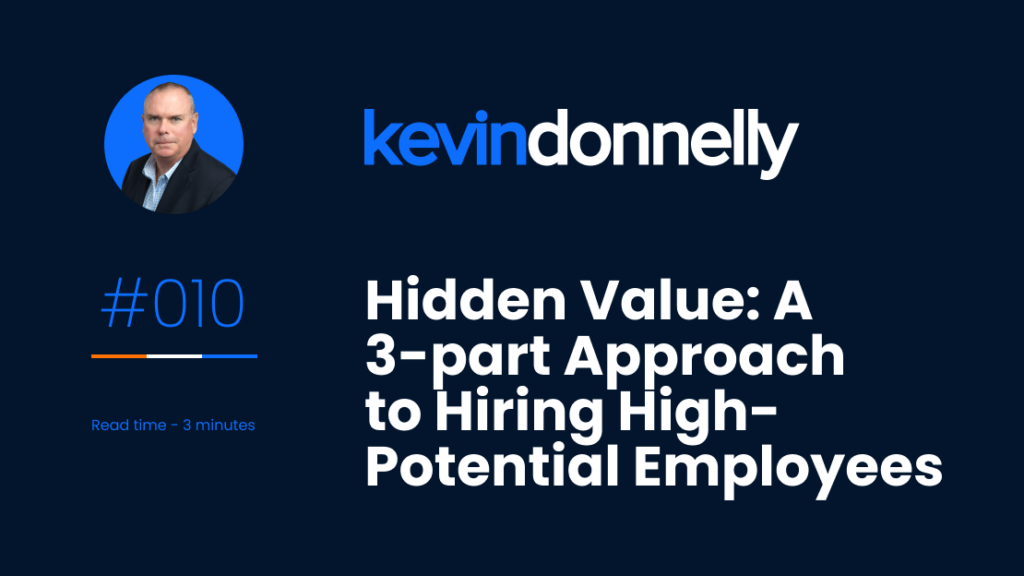Are you ready to meet your next level? Click here to book your free discovery call

French economist Jean-Baptiste Say characterized an entrepreneur as one who “shifts economic resources out of an area of lower and into an area of higher productivity and greater yield.” This expands the term’s literal translation from the French for “one who undertakes” to include the concept of value creation.
Bootstrapping founders epitomize the principle of creating more value with less resources, particularly when hiring. While it may be tempting to try and hire C-level executives with extensive resumes and impressive LinkedIn profiles, smaller businesses often cannot afford those seasoned professionals. To combat this, value creators need to develop a knack for hiring talented people about to blossom.
High Potential Employees, or HIPOs, might have thin resumes—but spotting their burgeoning talent allows you to create significant value that others overlook. This is challenging to do well, however, since most HIPOs have limited credentials for you to evaluate.
Here’s a three-part process for spotting HIPOs, developed by Skubana co-founder Chad Rubin, who built his company to $5 million in revenue with the help of a team of HIPOs before deciding to sell it to 3PL Central.
Rubin criticized the traditional hiring process as “broken.” How can you evaluate a candidate’s potential in just a 45-minute meeting? Rubin’s alternative solution comes in a three-part approach:
1. Hide a Golden Egg
Many young candidates apply for any (and every) job they come across, but Rubin sought detail-oriented applicants who took the time to understand his business and the specific role. He embedded an obscure request within each job posting to identify those who had read it in full. For instance, he asked candidates to include the name of their favorite ’90s band in their cover letter. Rubin’s intention wasn’t to compile a new playlist; he wanted to see who had read the entire posting.
2. Pattern Recognition
Aware that traditional interviews wouldn’t suffice to gauge a candidate’s potential, Rubin turned to pattern recognition assessments to evaluate their intelligence. He discovered an online puzzle that required candidates to recognize patterns in a set of images, and he found this to be a reliable measure of their intellectual potential.
3. Measure the Fit
Once satisfied with their cognitive abilities, Rubin aimed to gauge how well a candidate would mesh with his team. Instead of relying on a conventional interview, he used a Culture Index psychometric test to assess psychological attributes beyond IQ, thereby measuring their fit within the company culture.
Another psychometric assessment you can leverage is the Kolbe A Index. It measures the ways people instinctively take action and is a great barometer to use when evaluating the value that new employees will bring to your business.
Let’s walk through a concrete example of how you can use a Kolbe score to assist your hiring process. If you need a manager who will run the daily operations of your business, here’s what to look for on the four attributes Kolbe measures, on a scale from 1 to 10:
Fact Finder: 6-8
This attribute measures how someone gathers and shares information. For someone running the day-to-day operations of your business, look for the sweet spot of someone who gathers a lot of info before taking action, without succumbing to analysis paralysis.
Follow Thru: 5-8
This category focuses on how candidates organize and design. You’re looking for someone who initiates systems, structure, and organization, so they should score relatively high here.
Quick Start: 4-6
This one’s about how a candidate deals with risk and uncertainty. Look for someone with a healthy dose of risk aversion. Watch out though, because if they score too low, say a 1, they might not be a fit for an entrepreneurial company.
Implementor: 3-7
The last bucket covers how candidates handle space and tangibles. Ideally, you’ll find someone in the middle who is able to keep things working the way they should, and construct tangible solutions when needed.
This unique three-part hiring strategy, paired with these effective assessment tests, will empower you to consistently recruit high-potential employees—even when they’re entry-level—and unlock hidden value for your organization.
When you're ready here's 3 ways I can help You Build Value For Your Company.
1. Let me work with you on your hiring.
If you're having trouble finding and keeping the right people to help grow your business I can show you what I did to go from 80 to 600 over a couple of years. Check out our free hiring assessment quiz...
2. Let's talk about what your business could be worth.
If you're like a lot of people thinking about what their end game is and want to know what your business is worth now and what it could be worth. Take my FREE Value Assessment and then we can talk.
3. Work With Me 1:1
If you'd like to work directly with me to increase the value of your company and establish your End Game plan, book a time to talk.
Similar Posts

Kevin Donnelly
December 28, 2024
TAM vs. Target
As you enter the fourth quarter of the year, you may be starting to think about your marketing plans for 2023. Terms like Total Addressable Market (TAM) and Target Market...

Kevin Donnelly
December 21, 2024
Ownership Has Its Privileges
Walk down Nashville’s Lower Broadway any night of the week, and you can hear aspiring artists belting out cover tunes from Elton John to Garth Brooks. In many cases, these...

Kevin Donnelly
December 14, 2024
Do Not Poke the Giant
On June 1, 2011, both Floyd’s Coffee Shops in Portland, Oregon were busier than usual. The regulars were elbowed out of the way by new customers visiting the store for...
